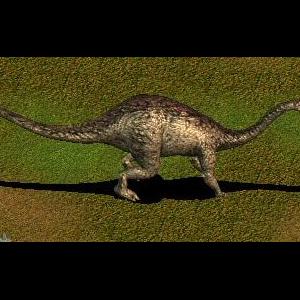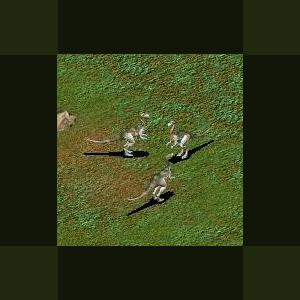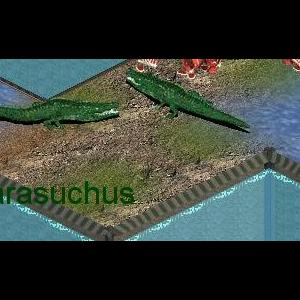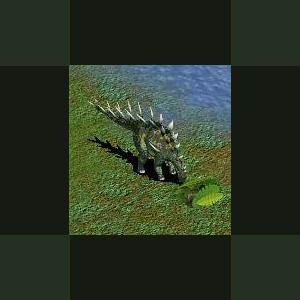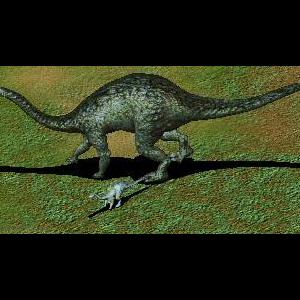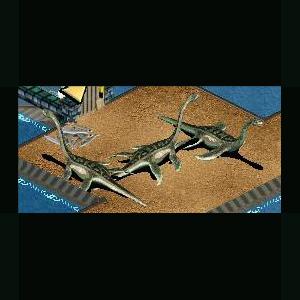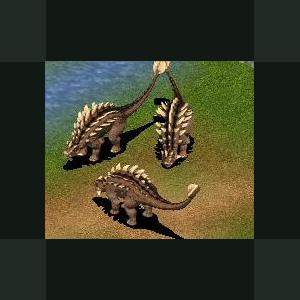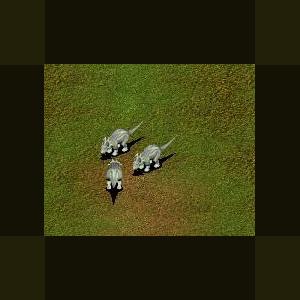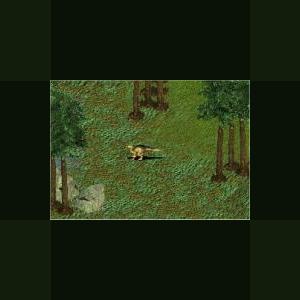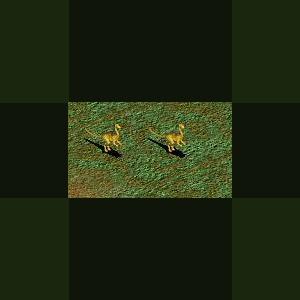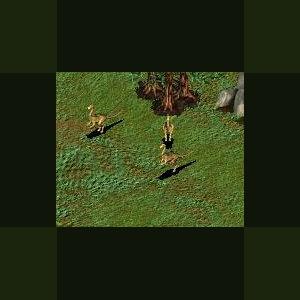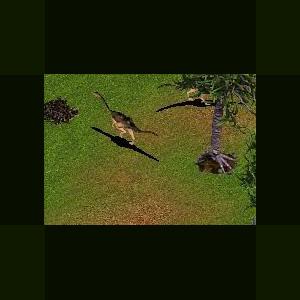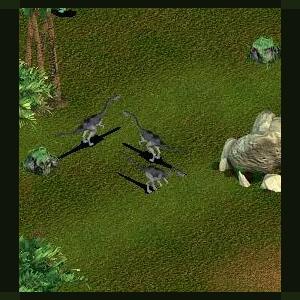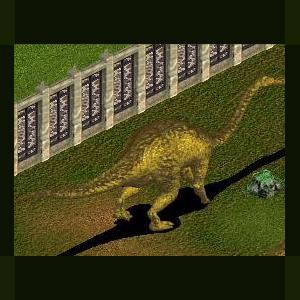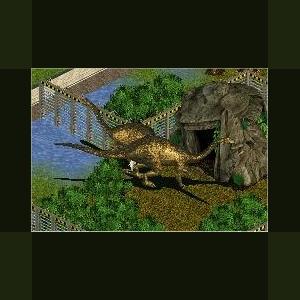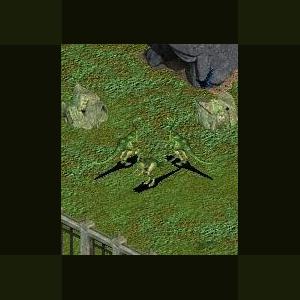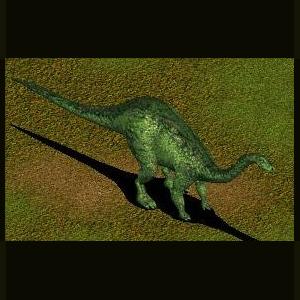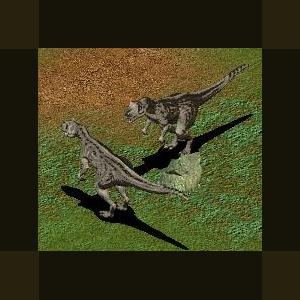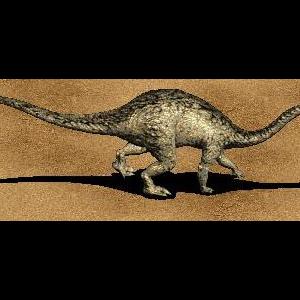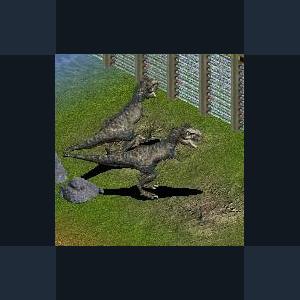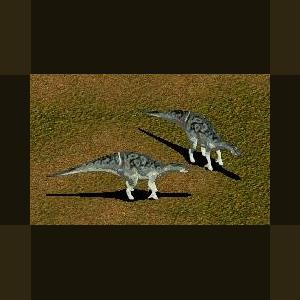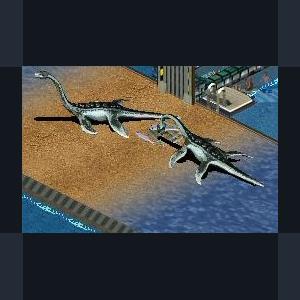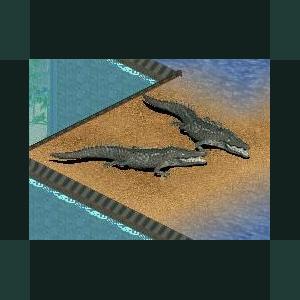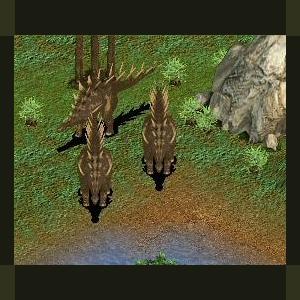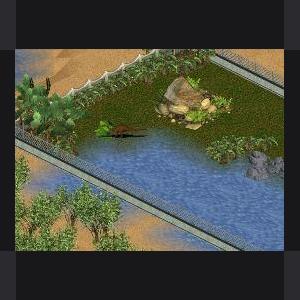Dinosaurs
Creatures from another age
241 files
-
Patagosaurus by Moondawg
By Guest
Patagosaurus
Patagosaurus (meaning "Patagonian lizard") was a large herbivorous dinosaur from the long-necked group Sauropoda. It reached the length of 18 meters. Similar to other primitive eusauropods, it was rather heavily build and similar to Cetiosaurus in general appearance. It is known from a dozen individuals, though some referred material may belong to another related dinosaur genus. It lived during the Callovian of the Middle Jurassic (163-161 mya) in what is now called Argentina. Other Argentinian dinosaurs living approximately at the same time were Piatnitzkysaurus, Condorraptor and Amygdalodon.
128 downloads
0 comments
Updated
-
Parksosaurus by Moondawg
By Guest
Parksosaurus
Parksosaurus ("William Parks's lizard") was a genus of hypsilophodont ornithopod dinosaur from the early Maastrichtian-age Upper Cretaceous Horseshoe Canyon Formation of Alberta, Canada. It is based on most of a partially articulated skeleton and partial skull, showing it to have been a small, bipedal, herbivorous dinosaur. It is one of the few described non-hadrosaurid ornithopods from the end of the Cretaceous in North America, existing around 70 million years ago.
Explicit estimates of the entire size of the animal have not been done, but William Parks found the hindlimb of his T. warreni to be about the same length overall as that of Thescelosaurus neglectus (93.0 centimeters (3.05 ft) for T. warreni versus 95.5 centimeters (3.13 ft) for T. neglectus), even though the shin was shorter than the thigh in T. neglectus, the opposite of T. warreni. Thus, the animal would have been comparable to the better-known Thescelosaurus in linear dimensions, despite proportional differences (around 1 meter (3.3 ft) tall at the hips, 2-2.5 meters (6.56-8.2 ft) long). The proportional differences probably would have made it lighter, though, as less weight was concentrated near the thigh. Like Thescelosaurus, it had thin cartilaginous plates along the ribs.
Parksosaurus has been considered to be a hypsilophodont since its description. Recent reviews have dealt with it with little comment, although David B. Norman and colleagues (2004), in the framework of a paraphyletic Hypsilophodontidae, found it to be the sister taxon to Thescelosaurus, and Richard Butler and colleagues (2008) found that it may be close to the South American genus Gasparinisaura. However, basal ornithopod phylogeny is poorly known at this point, albeit under study. Like Thescelosaurus, Parksosaurus had a relatively robust hindlimb, and an elongate skull without as much of an arched shape to the forehead compared to other hypsilophodonts.
Paleontologist William Parks described skeleton ROM 804 in 1926 as Thescelosaurus warreni, which had been discovered in what was then called the Edmonton Formation near Rumsey Ferry on the Red Deer River. When found, it consisted of a partial skull missing the beak region, most of the left pectoral girdle (including a suprascapula, a bone more commonly found in lizards, but which is believed to have been present in cartilaginous form in some ornithopods due to the roughened ends of their scapulae), the left arm except the hand, ribs and sternal elements, a damaged left pelvis, right ischium, the left leg except for some toe bones, articulated vertebrae from the back, hip, and tail, and a number of ossified tendons that sheathed the end of the tail. The body of the animal had fallen on its left side, and most of the right side had been destroyed before burial; in addition, the head had been separated from the body, and the neck lost. Parks differentiated the new species from T. neglectus by leg proportions; T. warreni had a longer tibia than femur, and longer toes.
Charles M. Sternberg, upon the discovery of the specimen he named Thescelosaurus edmontonensis, revisited T. warreni and found that it warranted its own genus (it was named in an abstract, which is not typical, but the specimen had already been thoroughly described). In 1940, he presented a more thorough comparison and found a number of differences between the two genera throughout the body. He assigned Parksosaurus to the Hypsilophodontinae with Hypsilophodon and Dysalotosaurus, and Thescelosaurus to the Thescelosaurinae. The genus attracted little attention until Peter Galton began his revision of hypsilophodonts in the 1970s. Parksosaurus received a redescription in 1973, wherein it was considered to be related to a Hypsilophodon\Laosaurus\L. minimus lineage. After this, it once again returned to obscurity.
George Olshevsky emended the species name to P. warrenae in 1992, because the species name honors a woman (Mrs. H. D. Warren), but outside of Internet sites, the original spelling has been preferred.
Parksosaurus shared the Horseshoe Canyon Formation with flat-headed hadrosaurid Edmontosaurus, spike-crested Saurolophus, and hollow-crested Hypacrosaurus, ankylosaurid Euoplocephalus, nodosaurid Edmontonia, horned dinosaurs Montanoceratops, Anchiceratops, Arrhinoceratops, and Pachyrhinosaurus, pachycephalosaurid Stegoceras, ostrich-mimics Ornithomimus and Struthiomimus, a variety of poorly-known small theropods including troodontids and dromaeosaurids, and the tyrannosaurids Albertosaurus and Daspletosaurus. The dinosaurs from this formation are sometimes known as Edmontonian, after a land mammal age, and are distinct from those in the formations above and below. The Horseshoe Canyon Formation is interpreted as having a significant marine influence, due to an encroaching Western Interior Seaway, the shallow sea that covered the midsection of North America through much of the Cretaceous.
In life, Parksosaurus, as a hypsilophodont, would have been a small, swift bipedal herbivore. It would have had a moderately long neck and small head with a horny beak, short but strong forelimbs, and long powerful hindlimbs.
120 downloads
0 comments
Updated
-
Parasuchus by Moondawg
By Guest
Parasuchus was a genus of several crocodile-like semi-aquatic animals that lived in the Late Triassic, specifically the earlier Late Carnian period. The reptiles lived throughout Europe, North America, and North Africa.
190 downloads
0 comments
Updated
-
Paranthodon by Moondawg
By Guest
Paranthodon (Meaning "Beside Anthodon") was a dinosaur from the middle of the Cretaceous. It lived in what is now South Africa.
It is classified as a stegosaur. The type species, Paranthodon africanus, comes from a partial skull first described as Palaeoscincus africanus in 1912. It was reclassified as Paranthodon africanus in 1929 by the famed Franz von Nopsca. It owes its name to the fact that its jaw was found near the fossils of a Permian pareiasaur named Anthodon.
* Inspired by the Zoo Tek Brains Trust
169 downloads
0 comments
Updated
-
Paralititan by Moondawg
By Guest
Paralititan stromeri was a giant titanosaurian sauropod dinosaur discovered in coastal deposits in the Upper Cretaceous Bahariya Formation of Egypt.
The fossil represents the first tetrapod reported from the Bahariya Formation since 1935. Its 1.69 meter (5.54 ft) long humerus is longer than that of any known Cretaceous sauropod. The autochthonous, scavenged skeleton was preserved in tidal flat deposits containing fossil mangrove vegetation. The mangrove ecosystem it inhabited was situated along the southern shore of the Tethys Sea. Paralititan is the first dinosaur demonstrated to have inhabited a mangrove biome.
Little of Paralititan is known, so its exact size is difficult to estimate. However the limited material suggests that it is one of the most massive dinosaurs ever discovered, with an estimated weight of 59 tonnes (65 short tons). Using Saltasaurus as a guide, Carpenter estimated its length at around 26 meters (85 ft). Like other titanosaurs, it had a wide-gauge stance and may have possessed osteoderms for defense. The Paralititan type specimen appears to have been scavenged by a meat-eater. It is also possible that Paralititan was hunted by large predatory dinosaurs such as Carcharodontosaurus.
Paralititan stromeri means "Stromer's tidal (Greek para + halos "near sea") titan". It was named by Joshua B. Smith, Matthew C. Lamanna, Kenneth J. Lacovara, Peter Dodson, Jennifer R. Smith, Jason C. Poole, Robert Giegengack and Yousri Attia in 2001 to honor Ernst Stromer von Reichenbach, a German paleontologist and geologist who found dinosaurs in this area in the early 1900s.
180 downloads
0 comments
Updated
-
Pantosaurus by Moondawg
By Guest
Pantosaurus is an extinct genus of plesiosaur from the Late Jurassic (Oxfordian) of what is now Wyoming. It lived in what used to be the Sundance Sea.
The species Muraenosaurus reedii is in fact a junior synonym of Pantosaurus
Pantosaurus possesses between 35 and 40 cervical vertebrae, which are very similar in proportion and morphology to those of Muraenosaurus leedsii from the Oxford Clay Formation (Callovian, Middle Jurassic) of England. The forelimb of Pantosaurus however can be differentiated from that of Muraenosaurus, such as the relatively large size of the radius and the corresponding humerus-radius articulation. No Pantosaurus cranial material has yet been discovered.
193 downloads
0 comments
Updated
-
Panoplosaurus by Moondawg
By Guest
Pantosaurus is an extinct genus of plesiosaur from the Late Jurassic (Oxfordian) of what is now Wyoming. It lived in what used to be the Sundance Sea.
The species Muraenosaurus reedii is in fact a junior synonym of Pantosaurus
Pantosaurus possesses between 35 and 40 cervical vertebrae, which are very similar in proportion and morphology to those of Muraenosaurus leedsii from the Oxford Clay Formation (Callovian, Middle Jurassic) of England. The forelimb of Pantosaurus however can be differentiated from that of Muraenosaurus, such as the relatively large size of the radius and the corresponding humerus-radius articulation. No Pantosaurus cranial material has yet been discovered.
161 downloads
0 comments
Updated
-
Pachyrhinosaurus by Moondawg
By Guest
Pachyrhinosaurus
Pachyrhinosaurus (meaning "thick-nosed reptile") is a genus of ceratopsid dinosaur from the Late Cretaceous period of North America. The first examples were discovered by Charles M. Sternberg in Alberta, Canada, in 1946, and named in 1950. Twelve partial skulls and a large assortment of fossils have been found in total in Alberta and Alaska. A great number were not available for study until the 1980s, resulting in a relatively recent increase of interest in the Pachyrhinosaurus. Instead of horns, the skull bears massive, flattened bosses, the largest being over the nose. These were probably used in butting and shoving matches, as in musk oxen. A single pair of horns grew from the frill and extended upwards. It appears that that both the shape and size of the frill was highly individualized, reliant on gender and perhaps other factors. Pachyrhinosaurus is most closely related to Achelousaurus.
Pachyrhinosaurus was 5.5 to 7 meters (18 to 23 ft) long. It weighed about four tons. It was herbivorous and possessed strong cheek teeth to help it chew tough, fibrous plants.
The type species, Pachyrhinosaurus canadensis, was described in 1950 by Charles Mortram Sternberg.
In 1972, Grande Prairie, Alberta science teacher Al Lakusta found a large bonebed along Pipestone Creek in Alberta. When the area was finally excavated between 1986 and 1989 by staff and volunteers of the Royal Tyrrell Museum of Palaeontology, paleontologists discovered an amazingly large and dense selection of bones--up to 100 per square meter, with a total of 3500 bones and 14 skulls. This was apparently the site of a mass mortality, perhaps a failed attempt to cross the river during a flood. Found amongst the fossils were the skeletons of four distinct age groups ranging from juveniles to full grown dinosaurs, indicating that the Pachyrhinosaurus did indeed care for their young.
The adult skulls had both convex and concave bosses as well as unicorn-style horns on the parietal bone just behind their eyes. The concave boss types might be related to erosion only and not reflect male/female differences. In 2008, a detailed monograph describing the skull of the Pipestone Creek pachyrhinosaur, and penned by Philip J. Currie, Wann Langston, Jr., and Darren Tanke, classified the specimen as a second species of Pachyrhinosaurus, named P. lakustai after its discoverer
282 downloads
0 comments
Updated
-
Othnielia by Ghirin
By Guest
Othnielia Author: Ghirin
Othnielia, a small ornithopod dinosaur, was named in honor of paleiotologist Othniel Charles Marsh.
*Inspired by the Zoo Tycoon Brains Trust at the Zoo Tek Evolved Forums.
169 downloads
0 comments
Updated
-
Oryctodromeus by Moondawg
By Guest
Oryctodromeus
Oryctodromeus (meaning "digging runner") was a genus of small ornithopod dinosaur, the fossilized remains of which have been found in rocks dating from the middle Cretaceous Blackleaf Formation of southwestern Montana (Cenomanian stage), roughly 95 million years ago. A member of the small, presumably fast-running herbivorous family Hypsilophodontidae, Oryctodromeus is the first dinosaur published that shows evidence of burrowing behavior.
Oryctodromeus is based on MOR 1636a, a partial skeleton of an adult individual including: the premaxillae (upper beak); part of the braincase; three neck, six back, seven hip, and twenty-three tail vertebrae; ribs; the shoulder girdle; an arm (minus the hand); both tibiae and an incomplete fibula; and a metatarsal. Two additional individuals, both juveniles about 55 to 65% the size of MOR 1636a, are represented by MOR 1636b. Unlike many other ornithopod dinosaurs, Oryctodromeus lacked bony tendons that stiffened the tail, which would have made moving about inside a small burrow easier. Additionally, it shows adaptations in the jaws, forelimbs, and pelvis that could have helped move and manipulate soil.
The authors pointed out that Oryctodromeus had only modest forelimb modifications in comparison to dedicated burrowing animals, like moles, echidnas, and wombats. Instead, it was comparable to, but somewhat more specialized for digging than animals that both run and burrow today, like aardwolves, cavies, hyenas, and rabbits. Because it was a biped, it could have a more modified forelimb without affecting its ability to run.
Under a cladistic analysis, Oryctodromeus was found to be basal within Euornithopoda and a close relative of the hypsilophodonts Orodromeus and Zephyrosaurus, which are also known from the Cretaceous of Montana. These two animals share adaptations with Oryctodromeus that may have been used for burrowing, such as a broad snout. Additionally, Orodromeus specimens have been found preserved in a similar way, suggesting that they too were in burrows. This would not be the first time that a hypsilophodont has been suggested as a burrower; Robert Bakker has informally claimed since the 1990s that Drinker, from the late Jurassic of Wyoming, lived in burrows, but this has yet to be published.
The three Oryctodromeus individuals were found buried within the remains of an underground den or burrow, measuring about 2 meters long (6.5 feet) and 70 centimeters wide (2.3 ft). The skeletons were densely packed and disarticulated, indicating that the animals died and decayed within the burrow. The burrow is similar to those made by hyenas and puffins today. It was filled with sand, and the resulting sandstone stands out against the surrounding mudstone and claystone.
There are two turns in the preserved burrow section, and smaller secondary sandstone cylinders of various sizes (a few centimeters or inches in cross-section at most) that were probably made by smaller animals sharing the burrow (commensal). The burrow closely fits the probable proportions of the adult dinosaur, another indication that it was the digger.
As a hypsilophodont, Oryctodromeus would have been a small, swift herbivore. This aspect, coupled with where it was discovered, gives it its name: Oryctodromeus cubicularis translates as "digging runner of the lair", in reference to its presumed lifestyle. The adult Oryctodromeus itself measured 2.1 m long (6.8 ft) and would have weighed about 22-32 kilograms (50-70 pounds), and the juveniles would have been about 1.3 m long (4.3 ft). The presence of juveniles with the adult suggests parental care, and that at least one motivation for burrowing was to rear the juveniles. The size of the juveniles suggests an extended period of parental care.
124 downloads
0 comments
Updated
-
Orodromeus by Moondawg
By Guest
Orodromeus
Orodromeus was a genus of hypsilophodont dinosaur from Late Cretaceous North America (Campanian age). It was a small herbivore that probably coexisted with dinosaurs such as Daspletosaurus and Einiosaurus. It lived in what is now Montana some 75 million years ago, being apparently only known from the Two Medicine Formation. The type species, Orodromeus makelai, was described by Horner and Weishampel in 1988.
It has been speculated that this animal may have burrowed much like its relative Oryctodromeus, based upon the packing of their bones in situations where they typically would have been scattered.
126 downloads
0 comments
Updated
-
Ornithomimus by Moondawg
By Guest
Ornithomimus velox was named on the basis of a foot and partial hand from the Maastrichtian Denver Formation, but better material has since been found in Canada, including the Edmontonian-age Ornithomimus edmontonicus and an excellent articulated specimen (species unknown) from Dinosaur Provincial Park. Other specimens of Ornithomimus have been discovered on the Eastern Coast of the USA
Like other ornithomimids, Ornithomimus is characterized by a three-toed foot, long slender arms and a long neck with a birdlike skull. It differs from other ornithomimids, such as Struthiomimus, in having very slender, straight hand and foot claws and in having metacarpals and fingers of similar lengths.Its hands are remarkably sloth-like in appearance, which led Henry Fairfield Osborn to suggest that they were used to hook branches during feeding.
Ornithomimus was 12 ft (3.5 meters) long, 7 feet (2.10 meters) high and weighed around 100-150 kg. It was bipedal and superficially resembled an ostrich, except for its long tail. It would have been a swift runner.
267 downloads
0 comments
Updated
-
Ornitholestes by Moondawg
By Guest
Ornitholestes
Ornitholestes ("bird robber") was a small theropod dinosaur of the late Jurassic of Western Laurasia (the area that was to become North America). Almost everything known of this species comes from a single skeleton of Ornitholestes, found near Como Bluff in 1900, and described by Henry Fairfield Osborn in 1903. A hand was later attributed to Ornitholestes, although this attribution is now in doubt. The species name honours the AMNH preparator Adam Hermann.
Ornitholestes was roughly 2 meters (6.5 ft) in length. The head of Ornitholestes was relatively small. Nonetheless, the skull was more robust than that of many other small theropods, such as Compsognathus and Coelophysis, and this would have enabled Ornitholestes to deliver a powerful bite.
Gregory S. Paul suggested the presence of a small horn on the snout of Ornitholestes, similar to that of Proceratosaurus. however this has recently been disproved by Carpenter et al., which indicated that the 'crest' was actually a broken nasal bone. Like most other theropods, Ornitholestes had a long tail, presumably used for balance
Ornitholestes was a coelurosaur, similar in many ways to Compsognathus, though somewhat larger.
The sharp teeth of Ornitholestes clearly identify it as a carnivore, but its exact diet has been a subject of debate in the paleontological community.
In his original 1903 description, Henry Fairfield Osborn suggested that Ornitholestes might have preyed on contemporary birds, based on the "rapid grasping power of agile and delicate prey" suggested by the structure of the hand. In 1917, however, Osborn reevaluated the hand and determined that it was unsuitable for this purpose.
More recently, Robert T. Bakker speculated that Ornitholestes probably hunted small mammals, noting that "the Como furballs were just the right size to fit the predator's jaws."
198 downloads
0 comments
Updated
-
Opisthocoelicaudia by Moondawg
By Guest
Opisthocoelicaudia
Opisthocoelicaudia (from Greek opisthe [back], koilos [hollow], and Latin cauda [tail], meaning posterior cavity tail) was a 39 foot-long (12 meter) sauropod of the Late Cretaceous Period discovered in Mongolia in 1965 by Polish and Mongolian scientists in the Gobi Desert (in the Cretaceous, Mongolia wasn't all desert: it also had lush jungles and murky marshes, which Opisthocoelocaudia might have waded in). It was described and named in 1977 by Borsuk-Bialynicka as a new type of camarasaur, but studies such as Salgado and Coria (1993) find it to be a saltasaurid titanosaur instead. Its skull and neck were missing and its carcass had apparently been buried before disintegrating. Borsuk-Bialynicka suggested tyrannosaurid scavengers had fed on the carcass, eating the head and neck and leaving noticeable tooth marks on the pelvis and femur. Scientists cannot be sure what its head or neck looks like, because neither was ever recovered.
Skeletally, it is generally similar to most other titanosaurs. It has, however, unique joints in the tail vertebrae which account for its unusual name. Each of the thirty four tail vertebrae has a large dome on the front and a deep hemisperical socket on the posterior, creating a series of strong ball-and-socket joints. There is also notable evidence of immense ligament and muscle tissue attached to the tail. The tail thus tends to slant slightly upwards, not downwards as in other sauropods. The suggestion has been that the tail was used as a prop to form a tripod with its back limbs for a feeding position.
Opisthocoelicaudia has appeared on stamps in its homeland of Mongolia and in the Republic of Guinea.
162 downloads
0 comments
Updated
-
Omeisaurus by Ghirin
By Guest
Omeisaurus by Ghirin
Description : Omeisaurus ("Mount O-mei Lizard") was a large sauropod from China.
It had a very long neck and some scientists think that it might be related to Mamenchisaurus. Others think that its more closely related to Shunosaurus.
176 downloads
0 comments
Updated
-
Noasaurus by Moondawg
By Guest
Noasaurus
Noasaurus ("Northwestern Argentina lizard") is the name given to a carnivorous dinosaur genus of the late Campanian-Maastrichtian (Late Cretaceous). It was a small (less than eight feet long) theropod, specifically a ceratosaur, discovered by Jaime Powell and Jose Bonaparte in northwestern Argentina. It was originally thought to have had a toe claw similar to that of dromaeosaurs, but independently developed, but this is now discredited: the "toe claw" was probably actually on the animal's hand. Compared to those avian-theropods, Noasaurus is old fashoned. It is likely a close relative of the larger abelisaurs that shared its habitat; they are both derived from the same Ceratosaurus-type basal ceratosaurian ancestor. The discovery of Masiakasaurus, a closely related animal from Madagascar, provides evidence for this new theory: it doesn't have a dromaeosaur-style toe claw.
Noasaurus ("Northwestern Argentina lizard") is the name given to a carnivorous dinosaur genus of the late Campanian-Maastrichtian (Late Cretaceous). It was a small (less than eight feet long) theropod, specifically a ceratosaur, discovered by Jaime Powell and José Bonaparte in northwestern Argentina. It was originally thought to have had a toe claw similar to that of dromaeosaurs, but independently developed, but this is now discredited: the "toe claw" was probably actually on the animal's hand.
Compared to those avian-theropods, Noasaurus is old fashoned. It is likely a close relative of the larger abelisaurs that shared its habitat; they are both derived from the same Ceratosaurus-type basal ceratosaurian ancestor. The discovery of Masiakasaurus, a closely related animal from Madagascar, provides evidence for this new theory: it doesn't have a dromaeosaur-style toe claw.
The type species, Noasaurus leali, was described by Bonaparte and Powell in 1980.
124 downloads
0 comments
Updated
-
Nigersaurus by Moondawg
By Guest
Nigersaurus (meaning Niger lizard) was a relatively small sauropod (15 meters long) that was described in 1999, and which lived in the middle Cretaceous period, about 119-99 million years ago.
It is one of the most common genera found in the rich fossil vertebrate fauna of the Elrhaz Formation, Gadoufaoua, in the Niger Republic, discovered by Philippe Taquet, and described in a paper published in 1976. Like other sauropods from what used to be Gondwana, it had a shorter neck than Laurasian sauropods like Barosaurus. Nigersaurus had to protect itself from carnivores such as Sarcosuchus.
Nigersaurus (meaning Niger lizard) is a genus of diplodocoid sauropod dinosaur from the middle Cretaceous period, about 119 to 99 million years ago during the Aptian or Albian age. This dinosaur was described by Paul Sereno and colleagues in 1999. It is one of the most common genera found in the rich fossil vertebrate fauna of the Elrhaz Formation, Gadoufaoua, in the Niger Republic, discovered by Philippe Taquet, and described in a paper published in 1976.
Nigersaurus was a plant-eater that had an unusual mouth shaped like the wide intake slot of a vacuum that took in food and over a hundred very small, sharp teeth for chewing. Previously, such tooth batteries have been known only in hadrosaur and ceratopsian dinosaurs, but the discovery of Nigersaurus showed that at least one sauropod lineage, the rebbachisaurids, had them, as well.
Like other sauropods from what used to be Gondwana, it had a shorter neck than Laurasian sauropods like Barosaurus. Despite these stockier proportions, Nigersaurus reached about 9 meters (29.5 ft) in length. At nine meters in length, Nigersaurus was smaller than other members of the Rebbachisaur family, such as Rebbachisaurus itself, a large animal with a distinctive low spinal ridge on its back. Nigersaurus, although smaller, had a similar ridge, which in life would have consisted of skin and perhaps also flesh stretched across elongate neural spines in the vertebrae.
Although a common genus, Nigersaurus had been poorly known until 2005, because of the delicate and highly pneumatic (filled with air spaces) construction of the skull and skeleton, which means that the fossil remains have been disarticulated. Sereno and Jeffrey A. Wilson in 2005 provided the first description of the skull and feeding adaptations. Nigersaurus had as many as 500 or 600 teeth in its shovel-shaped head. Like the earlier diplodicids, its head was oriented downwards and was best suited for low level browsing.
According to the New York Times, an article published in the Public Library of Science (PLoS) in late November 2007 details the unique anatomy of Nigersaurus. The genus is reported to have had a relatively short neck with the head oriented towards the ground; it is thought to have been a ground-level browser like a modern cow. The Times reports
In contrast to other plant-eating dinosaurs, this one had more than 50 columns of teeth, all lined up along the jaws’ front edges, forming, in effect, foot-long scissors. The CT scans of the jawbones showed up to nine replacement teeth stacked behind each cutting tooth. When one wore out, another immediately took its place, at a rate, perhaps, of one a month in each column. 'Among dinosaurs,' Dr. Sereno said, 'Nigersaurus sets the Guinness record for tooth replacement.'
176 downloads
0 comments
Updated
-
Neovenator by Moondawg
By Guest
Neovenator ("New-Hunter") is a genus of allosauroid dinosaur. Since its discovery on the Isle of Wight, UK, it has become one of the best-known large carnivorous dinosaurs in Europe.
Neovenator was at first considered possibly a new species of Megalosaurus. It measured approximately 7.5 meters in length, and was of a gracile build. It lived during the Barremian stage of the Cretaceous Period.
The first bones of the type species were discovered in 1978, in the chalk cliffs of southwest Isle of Wight. It was much later (1996) that more bones from this specimen were found. Excavations undertaken by Dr Steve Hutt and his team have so far revealed approximately 70% of the skeleton.
At the time that it was described, by Steve Hutt, Martill and Barker in 1996, it was the only known allosaurid in Europe. It is currently considered to be closely related to Allosaurus, Acrocanthosaurus and Giganotosaurus.
A life-sized, animatronic model of the animal is on display at the Dinosaur Isle attraction in the Isle of Wight.
166 downloads
0 comments
Updated
-
Nemegtosaurus by Moondawg
By Guest
It was named after the Nemegt Basin in the Gobi Desert, where the remains were found. It may have had a long, sloping head and, like most sauropods, had peg-shaped teeth.
The type species, Nemegtosaurus mongoliensis, was first described by Nowinski in 1971. A second species, N. pachi, was described by Dong in 1977, but is a nomen dubium.
173 downloads
0 comments
Updated
-
Nanotyrannus by Moondawg
By Guest
Nanotyrannus ("tiny tyrant") is a genus of tyrannosaurid dinosaur, and is possibly a
juvenile specimen of Tyrannosaurus. Represented only by a small skull it was discovered by Charles W. Gilmore in 1942 and described in 1946 as a
specimen of Gorgosaurus lancensis (now known as Albertosaurus).In 1988, the
specimen was re-described by Robert T. Bakker, Phil Currie, and Michael Williams,
the late curator of paleontology at the Cleveland Museum of Natural History, where
the original specimen was housed and is currently on display. Initial research indicated
that the skull bones were fused, and that it therefore represented an adult specimen.
In light of this, Bakker and colleagues assigned the skull to a new genus, which they
named Nanotyrannus for its apparently small size.However, subsequent work has cast
doubt on this, and some paleontologists no longer consider it a valid genus--since the
fossil was a contemporary of Tyrannosaurus rex, many paleontologists now believe it to
be a juvenile T.rex, especially since the discovery in 2001 of new Nanotyrannus specimen,
nicknamed "Jane." The original Nanotyrannus specimen is estimated to have been around
17 feet (5.2 meters) long when it died.
In 2001, a more complete juvenile tyrannosaur ("Jane"),
belonging to the same species as the original Nanotyrannus specimen, was uncovered.
In 2005, a conference on tyrannosaurs focused on the issues of Nanotyrannus validity
brought about by the discovery of the Jane specimen, was held at the Burpee Museum of
Natural History. Several paleontologists, such as Phil Currie and Donald M. Henderson,
saw the discovery of Jane as a confirmation that Nanotyrannus was a juvenile T. rex or
closely related species.Peter Larson, on the other hand, continued to support a
separate genus for Nanotyrannus.The actual scientific study of Jane, set to be
published by Bakker, Larson, and Currie, may help determine whether Nanotyrannus is a
valid genus, whether it simply represents a juvenile T. rex, or whether it is a new
species of a previously identified genus of tyrannosaur.
Bakker has stated he believes Nanotyrannus hunted in packs. Teeth from multiple Nanotyrannus have been found in the bones of herbivorous dinosaurs.
In 2008, Nanotyrannus was featured in the second episode of Jurassic Fight Club, a pseudo-documentary about prehistoric predators.[8] The episode dismissed the ongoing scientific debate on the validity of the Nanotyrannus genus, with the producers preferring instead to present a speculative battle between two juvenile Tyrannosaurus and one Nanotyrannus (which was possibly a juvenile Tyrannosaurus). The episode depicted both genera as having pronated hands (hands with downward or backward-facing palms), something tyrannosaurids could not do.[9] The episode relied heavily on speculation to determine who would be the victor in the battle between the similar (or possibly synonymous) genera. Some television reviewers felt the battles depicted in the series were over-hyped and remarked negatively on the producers and experts' speculation about what the animals were thinking.[10]
191 downloads
Updated
-
Naashoibitosaurus by Moondawg
By Guest
Naashoibitosaurus (meaning in Navajo na‘asho‘i "lizard creek") is a genus of hadrosaurid dinosaur that lived about 73 million years ago.
Naashoibitosaurus, based as it is on a single partial skeleton, is not well-known in terms of anatomy. Its skull, the most thoroughly described portion, has a low nasal crest that peaks in front of the eyes, but does not strongly arch as in Gryposaurus.
Naashoibitosaurus is a hadrosaurine hadrosaurid, a "flat-headed or solid-crested duckbill". It is closest to the solid-crested forms like Saurolophus. If it is the same as Kritosaurus, Kritosaurus would be used because it is the older name, but its position vis-a-vis other duckbills would be the same.
Befitting a genus with a confusing taxonomic history, the name of this genus is based on an error. David Gillette and David Thomas collected the type and only known specimen from what was thought to be the Naashoibito Member of the Kirtland Formation, the youngest member of the Kirtland; this was commemorated in the name. Instead, it came from the older, late Campanian-age De-na-zin Member. Horner described the skull in 1992 as that of an immature Kritosaurus, using it as evidence that Gryposaurus was different from Kritosaurus. At the same time, Hunt and Lucas were describing the postcrania as belonging to Edmontosaurus saskatchewanensis. When the disconnect became apparent, Hunt and Lucas gave the specimen its own generic name, because the skull did not agree with an edmontosaur, and they considered Kritosaurus indeterminate and thus not usable.
131 downloads
0 comments
Updated
-
Muraenosaurus by Moondawg
By Guest
Muraenosaurus ('moray eel lizard') is an extinct genus of sauropterygian reptile belonging to the plesiosaur order. It lived in Late Jurassic Europe, and grew to 30 feet (8 m) long. Half of its length was its neck, which consisted of 44 vertebrae. Its skull was small.
240 downloads
0 comments
Updated
-
Mourasuchus by Moondawg
By Guest
Mourasuchus is an extinct genus of giant crocodilian from the Miocene of South America.
218 downloads
0 comments
Updated
-
Monkonosaurus by Moondawg
By Guest
Monkonosaurus
Monkonosaurus (meaning "Monkon lizard") is the name given to a genus of dinosaur from the Late Jurassic (Kimmeridgian stage, around 150-155 million years ago). It was a stegosaur which lived in what is now Tibet. The type specimen, Monkonosaurus lawulacus was formalized by Zhao in 1983, but is based only on one partial skeleton.The fragmentary condition of this single skeleton places doubt on the validity of this genus.
148 downloads
0 comments
Updated
-
Mokele Mbembe by Ghirin
By Guest
Mokele-mbembe, a name that means "One who stops the flow of rivers", is a legendary animal from the Likouala swamp region of the Central African Republic. It is usually described as having a small head on a long neck, a long, tail, rounded feet with three claws on each foot, and to be intermediate in size between an elephant and a hippopatamus The skin is hairless and reddish brown in color.
Mokele-mbembe is said to live in the pools and wetlands near rivers. It is herbivorous, prefering the malambo plant (Landolphia sp.). The animal is reported to spend most of its time in the water, only coming onto dry land to feed.
Some cryptozoologists believe that Mokele-mbembe is a surviving population of sauropod dinosaurs from the Mesozoic era. Many reports of the creature have come from the Congo region and several expeditions have been organized, but no actual specimenes, living or dead have been recovered for scientific study.
*Inspired by the Zoo Tycoon Brains Trust at the Zoo Tek Forums.
References:
http://www.mokelembembe.com/
http://www.geocities.com/Area51/Cavern/7270/mokele.html
http://www.angelfire.com/mi/dinosaurs/mokele.html
http://www.occultopedia.com/m/mokele_mbembe.htm
Created by Ghirin 2004
312 downloads
0 comments
Updated

